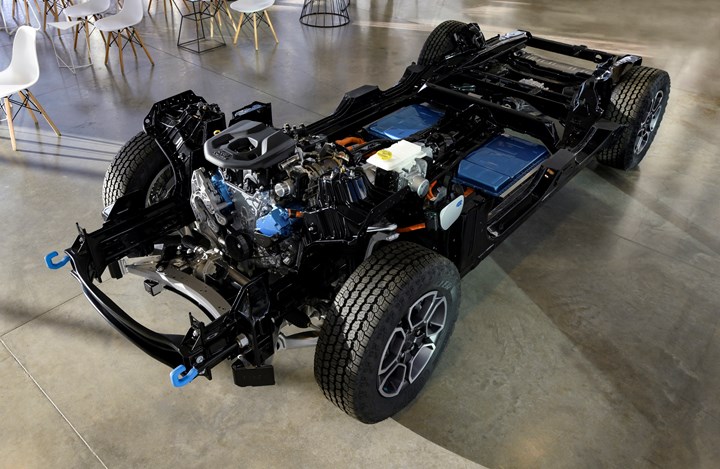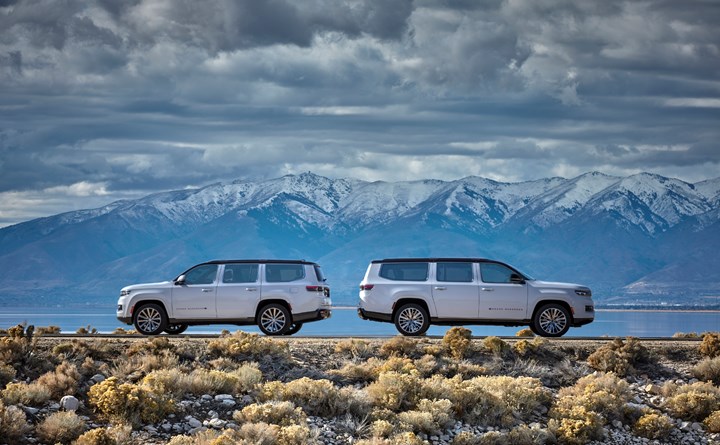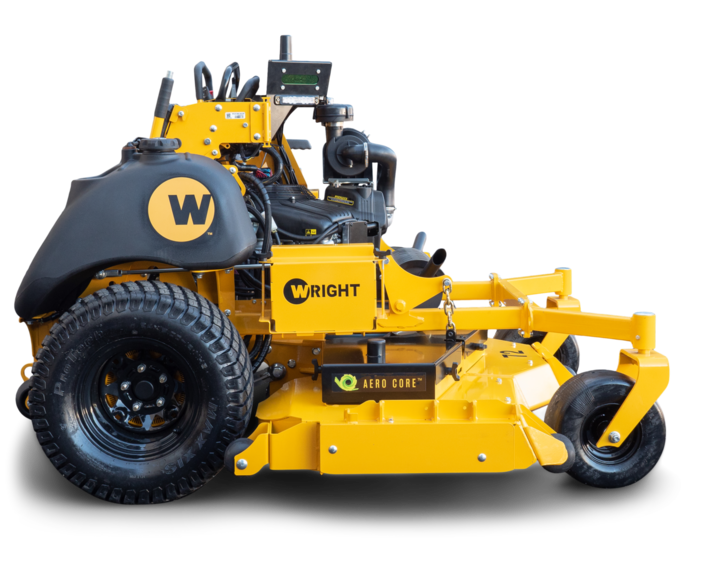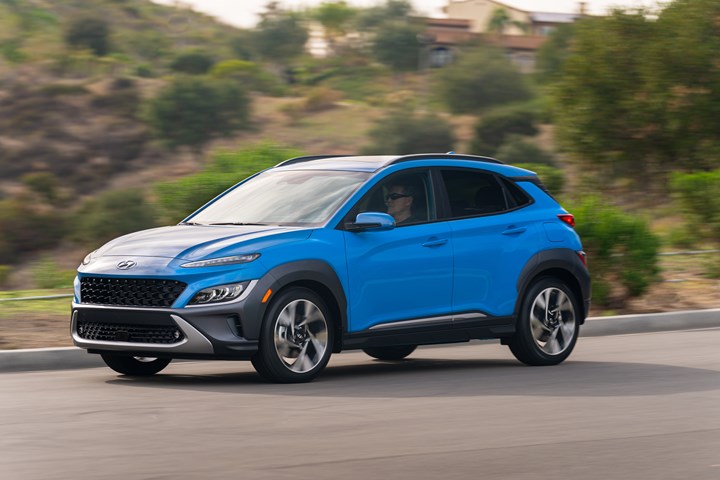on Jeeps (Hybrid and Longer), Autonomous Tech for Lawn Mowers, & a Look at the Hyundai Kona
The Jeep Grand Cherokee gets an electric boost. . .The Jeep Grand Wagoneer gets extra length. . .Autonomy comes to commercial lawn mowing. . .Diesel sales in Europe sustained by hybrid architectures. . .The Hyundai Kona: is it really a crossover?
The Electrifying 2022 Jeep Grand Cherokee 4xe Revealed

Under the skin of the Grand Cherokee 4xe. (Those blue rectangles about midway back are the batteries.) (Image: Jeep)
On July 15, 2021, Jeep celebrated its 80th anniversary. And Christian Meunier, Jeep Brand CEO, took the opportunity to announce, “We are fully committed towards a vision of zero emissions future, and by 2025 we will be offering a zero-emission fully electric Jeep 4xe in every SUV segment.”
It was the official launch of the “Zero Emission Freedom” initiative.
At the time, Jeep had one bona-fide PHEV in its lineup, the Wrangler 4xe, which was launched in September 2020.
The Wrangler—which has its direct roots in that Jeep circa 1941--is the second-best selling model in the brand’s lineup, and having a plug-in hybrid (PHEV) model helped improve the overall sales of Wranglers in 2021 (total 2021 sales for Wrangler: 204,610).
The biggest selling model in Jeep’s lineup is the Grand Cherokee (264,444 units in 2021), and until the launch of the Grand Wagoneer last year, the Grand Cherokee was the lux offering in the Jeep showroom—yet it still has all of the stuff that makes it a Jeep that can handle conditions from rocks to weather that would leave other vehicles by the side of the trail or road.
So given Meunier’s commitment and the Wrangler 4xe’s success, the development of a Grand Cherokee 4xe simply makes sense. Know that Jeep launched the fifth-gen Grand Cherokee last fall; the engineering of a PHEV architecture was taken into account when the new platform was developed.
Leveraging Scale
According to the U.S. Energy Information Administration, the average price of gas in the U.S. the first week of January 2022 was $3.39 per gallon. The week of April 18 had that up to $4.06.
Let’s face it: hybrids, compared to straight ICEs, have had modest success, in part due to comparative higher prices (predicated mainly on the addition of the electric motor system to the powertrain).
So the Jeep engineers did something clever to help make the Grand Cherokee 4xe more affordable (starting MSRP is $57,700): they are leveraging economies of scale by using the same powertrain setup as that used for the Wrangler 4xe—though know that Eunjoo Hopkins, Vehicle Synthesis Manager, points out that calibrations are vehicle-specific and adjustments had to be made for things like battery location for the 400-v, 17.3-kWh Li-NMC batteries (which, she points out, are protected by 3.5-mm thick skid plates—the Grand Cherokee 4xe may be highly refined, but it is a Jeep).
Think about it: sharing the powertrain increases volumes so even in circumstances when hybrids are not as popular as they are now due to the sudden gas price rise, there is a greater likelihood of more hybrid vehicles being made and sold.
What Makes the Grand Cherokee 4xe Go
The powertrain setup:
Engine:
- 2.0-liter turbo I4
- 270 hp @ 5,250 rpm
- 295 lb-ft of torque @ 3,000 rpm
Integrated Transmission Traction Motor:
- Peak power: 134 hp
- Peak torque: 195 lb-ft
- Note: By integrating the motor into the transmission, no torque converter is required
Transmission:
- 8P75PH-PHEV eight speed automatic
eTorque Belt-Start Generator Motor:
- Peak power: 44 hp
- Starting torque: 39 lb-ft
- Note: This high-voltage, liquid-cooled unit replaces the alternator. It is connected to the engine crankshaft pulley with a belt. It facilitates smooth start-stop operation and generates electricity for the battery pack
Total Powertrain Output:
- Peak combined power: 375 hp @ 5,250 rpm
- Peak combined torque: 470 lb-ft @ 3,000 rpm
Yes, a Bona-fide Jeep
The Grand Cherokee 4xe offers 25 miles of all-electric range (I can testify to the validity). The total driving range is 470 miles.
The vehicle is available with Jeep 4x4 systems (Quadra-Trac II and Quadra-Drive II).
It has an air suspension system (not surprisingly, it is named “Quadra-Lift”).
The air suspension provides up to 10.9 inches of ground clearance. And contributes to the ability to ford 24 inches of water. Yes, all of the high-voltage electronics are sealed and waterproof.
Why a Motor Matters to Crawling
While it might seem that the Grand Cherokee 4xe exists mainly as Jeep Brand addresses the burgeoning environmental vehicle regulations (and Meunier’s directive), the electrification actually provides a benefit to those who actually take their vehicles off road and crawl challenging terrain.
Take a Trailhawk 4xe out on the rocks and you’ll quickly realize that when operating in electric mode there is more precise control of propulsion than there is when driving an internal combustion engine-powered vehicle (the electric motor operates in a linear manner).
I can vouch for that, too. Although I continue to be mystified by why anyone would take such a wonderfully executed Jeep on terrain where you are slamming the stuff out of it.
///
Jeep Grows the Wagoneer

What a difference a foot makes: Grand Wagoneer (left), Grand Wagoneer L (right). (Image: Jeep)
While on the subject of Jeeps. . .
Knowing that a Jeep Wagoneer/Grand Wagoneer (W/GW) has a wheelbase of 123 inches, an overall length of 214 inches, a body width of 83.6 inches, and a height of 75.6 inches probably doesn’t provide too much in the way of picturing just how large the vehicle is.
But knowing that the W/GW is manufactured at the Warren Truck Assembly Plant along with the Ram 1500 Classic light-duty pickup truck—yes, a full-size pickup--probably gives a better sense that this is a big utility vehicle.
But now there is the Wagoneer L and Grand Wagoneer L.
“L” means long. Bigger.
As in a 130-inch wheelbase. An overall length of 226.7 inches. A height of 79.6 inches.
Or simply, compared to the already big W/GW, there are the addition of seven inches to the wheelbase, a foot and change to the overall length and four inches to the height.
The L versions offer 179.3-cu. ft. of passenger volume. And 44.2 cu. ft. of cargo volume behind the third row.
Structurally speaking
Compared with the non-L:
• New body-in-white rear floor
• New body-in-white rear ladder structure
• New body-in-white third-row seat brackets and reinforcements
• New frame center rail and rear rail extension
• New rear tub
• New load floors
Yes, the L is all the W/GW are and then some.
Materials
The structure of the body-on-fully boxed-frame vehicle makes extensive use of high-strength steel to provide safety while minimizing weight. It should also be noted that these vehicles are Jeeps, so there has to be the wherewithal to deal with Jeep-like driving conditions.
Another weight save: aluminum is used for the hood and the doors. The liftgate is a composite.
“Light” is a relative term when it comes to the Ls. The curb weight ranges from 6,068 to 6,685 pounds.
///
We Are in Spring & Lawns Are Growing

An autonomous mower for lawn cutting. (No, not something you’d buy for your house, unless you happen to have acres of turf.) (Image: Wright Manufacturing)
Wright Manufacturing builds lawn mowers. Mowers for commercial applications. Mowers that you’re likely to see on a golf course or a football field. Mowers for big jobs.
Greenzie is a company made up of software engineers and roboticists. Folks who are interested in developing systems for autonomous vehicles. Systems that deploy, says Charles Brian Quinn, co-founder and CEO, “off-the-shelf automotive grade sensors” and industrial controls. Like DepthAI cameras from Luxonis. Ouster lidar. An x86 computer from Rugged Science.
For lawn mowing applications.
Each to Its Own
Quinn and his colleagues figure that companies like Wright know the vehicle side of things. . . so they’ve gotten together and developed the Robotic ZK mower, available with a 61-inch deck and a 27-hp engine or a 72-inch deck and a 40-hp engine.
Quinn uses the “not-reinventing-the-wheel” notion not only for working with Wright, but also from the point of view that they’re deploying the commercially available tech, as well as Linux and the open-source ROS to build the system software.
While Quinn acknowledges some similarity with automotive autonomous driving development capabilities, there are some notable differences.
As in lawn mowers are unlikely to encounter other lawn mowers as they move along the terrain (to say nothing of random pedestrians, bike riders, construction zones, etc.).
How to Cut a Lawn (Robotically)
The approach taken for the first time a field is to be mowed is for the ZK mower to be driven manually around the periphery of the area to be mowed. That geographic information is then used by the system to calculate the path within that area. The operator takes the mower out of manual mode, switches it to autonomous, and off it goes.
Should the sensors pick up anything that is anomalous, the mower comes to a stop. Greenzie is using Fort Robotics tech for e-stop capabilities.
Quinn says that the lawn care industry is facing a labor shortage (what isn’t?) that the autonomous mowers can help address. A typical three-person crew can go to two.
And, yes, the Greenzie system is setup for over-the-air updates.
///
Diesels in Europe—Hybridization Helps (But Not a Whole Lot)

Mercedes OM 654 2.0-liter,four-cylinder diesel engine with the second-generation integrated starter-generator (ISG) and a 48-volt electrical system. (Image: Mercedes)
At present, the number of vehicles you can buy at your local dealer from a Traditional Three OEM that has a diesel and isn’t a heavy-duty truck is but a handful. Things like the Jeep Gladiator and the Chevy Silverado, the Ram 1500 and the Cadillac Escalade (!) among them.
Diesels have always been more popular in Europe than in the U.S. so the range of offerings has been bigger.
But even there the interest in compression combustion is going away, according to recent figures from LMC Automotive.
Its most recent “Western European Diesel Car Market” report, while noting that the engine has had “relative stability” in market share over the past two quarters, goes on to say:
“Further decline is inevitable though and may be accelerated by steep price increases at the diesel pump. Gasoline prices have risen a little less which heightens the attractiveness of that fuel type over diesel while BEV looks increasingly alluring from a fuel price standpoint as liquid road fuels continue at near‐record price levels across the region.”
By Segments
Diesels are essentially done in A-segment cars and LMC reports, “it is close to extinction in the B-segment.”
But “diesel remains a crucial component of the D- and E-segments and is still significant in the C-segment.”
That said, LMC calculates that the share of new car sales in Europe with a diesel in March 2022 was 18%--down from 24% in March 2021.
One the reasons diesel continues to have popularity in the larger car segments in Europe: there is the availability of mild hybrids with diesels.
LMC notes that mild hybrids accounted for 26% of March diesel car sales in Germany.
Overall diesel share of market in Germany in March? 25.4%, down 2.3% from a year earlier.
Somewhere Nicolaus August Otto is shaking his head, sadly.
///
2022 Hyundai Kona Limited AWD

The 2022 Hyundai Kona. Lots of style. Reasonable utility. (Image: Hyundai)
The Hyundai Kona is categorized as a “small SUV.” I suppose that’s as good as any categorization. There is the cladding around the tops of the wheels as well as along the sill. That provides the SUV cred, perhaps. But when I look at the 6.7 inches of ground clearance, I think more of “small hatch” than SUV.
What’s more, there is the Hyundai Venue added to the lineup that has styling that stridently says “SUV.” I think the Kona is simply far more stylish and engaging.
Still, when the market is all about SUVs rather than almost anything else (you can put pickups in the demand space, which would lead us to the Santa Cruz, which has a box on the back, but which Hyundai swerves from having it going head-to-head with something like the Ford Maverick by calling it a “sport adventure vehicle” rather than a truck), the positioning as an SUV makes sense.
The Kona debuted in 2018 as Hyundai’s B-segment offering against the likes of the Jeep Renegade and the Honda HR-V, both vehicles that look like, well, SUVs, and the Chevy Trax, which looks more car-like, along the lines of the Kona.
Yet of those vehicles, when it comes to sales the Kona is second to the HR-V and well ahead of the Renegade and Trax.
(Random thought: When people go for small CUVs, is the objective to have something that “looks” like a utility vehicle or is it because they want something that may have AWD capability? Or is it simply because the number of available small and compact cars has shrunk such that if you’re in the market for small, your choices are now pretty much in the CUV space?)
The styling from the Hyundai studios (the Korean, European and American teams compete for their parts of the vehicles that get produced) on most vehicles is well above average, and the Kona is one that is sporty in looks, utile in functionality, so perhaps it really is a “sport utility vehicle.”
Some Sacrifice for Style
A comparison of dimensions shows that a sporty look means a sacrifice of some space.
Let’s compare the dimensions of the Kona and the more rectangular Jeep Renegade and see how a more upright appearance provides some advantages in interior space for those who are so inclined to make that the primary consideration.
The two are about proximate in exterior dimensions:
- Wheelbase Kona/102.4 in. Renegade/101.2 in.
- Length Kona/165.6 in. Renegade/166.6 in.
- Width Kona/70.9 in. Renegade/74.2 in.
- Height Kona/61 in. Renegade/66.5 in.
The wider and higher Renegade means that it has a passenger volume of 100.1 cubic feet while the Kona is at 94.1 cubic feet.
The Renegade has 18.5 cubic feet of cargo capacity behind the second row and 50.8 cubic feet with the second row folded.
The numbers for the Kona are 19.2 and 45.8 cubic feet, respectively.
Yet for all that, the Kona scores higher on style points, and when it comes to cargo capacity, odds are most people don’t fold the second row when making their Costco runs, so the 19.2 cubic feet behind the second row of the Kona is a practical win.
Stuffed with Stuff
There are rain-sensing wipers and a power sunroof for when that rain isn’t falling.
There is leather for the seats and automatic temperature control for when you’re sitting on them.
There is a 10.25-inch digital instrument cluster for the driver and a 10.25-inch touchscreen in the center console for infotainment.
There is a wireless charging pad for phones. There are Android Auto and Apple CarPlay.
There is a 2.0-liter 147-hp engine. There is a seven-speed dual-clutch automatic transmission.
There is plenty more.
And notably, there is active, on-demand AWD, so when there is a need for a bit of the ute, it’s there.
RELATED CONTENT
-
Engineering the 2019 Jeep Cherokee
The Jeep Cherokee, which was launched in its current manifestation as a model year 2014 vehicle, and which has just undergone a major refresh for MY 2019, is nothing if not a solid success.
-
Choosing the Right Fasteners for Automotive
PennEngineering makes hundreds of different fasteners for the automotive industry with standard and custom products as well as automated assembly solutions. Discover how they’re used and how to select the right one. (Sponsored Content)
-
Cobots: 14 Things You Need to Know
What jobs do cobots do well? How is a cobot programmed? What’s the ROI? We asked these questions and more to four of the leading suppliers of cobots.


.jpg;width=70;height=70;mode=crop)






